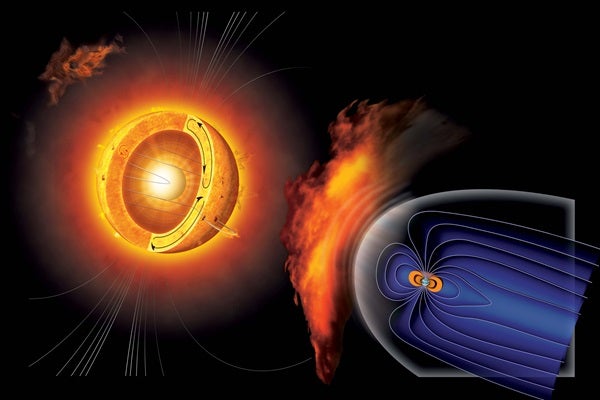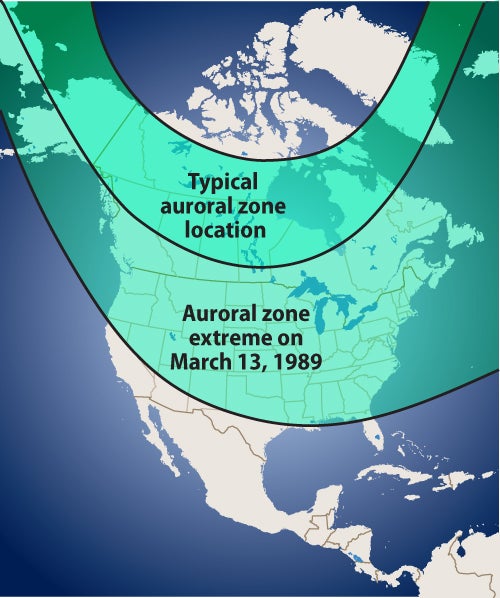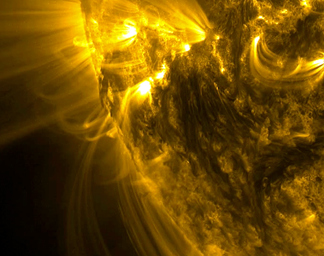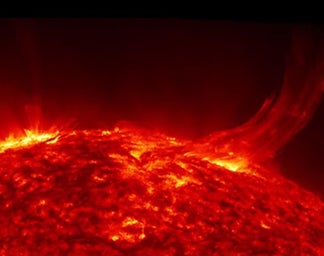This story originally appeared in September 2013 as “Solar storm warning.”
Montreal’s vast underground pedestrian system was far from crowded that cold Sunday night in March 1989 as graveyard-shift workers avoided the streets above. Without so much as a warning flicker, everything went black before battery backup spotlights illuminated wall sections like torches. Elevators stopped with a jolt, their occupants trapped. Streetlights throughout the Quebec province went out as a tenth of Canada’s population plunged into a total blackout.
The cause? Space weather.
But the agent of destruction didn’t come here from Mars or the Orion Nebula or interstellar space. It came from the Sun. The long-awaited solar maximum, when the Sun sizzles with the greatest storms, flares, and prominences of the past 13 years, occured in 2013.
Slammed by the Sun
In 1971, scientists at the U.S. Naval Research Laboratory first discovered that the Sun sometimes lets parts of it go. David Roberts, an electronics technician at the Orbiting Solar Observatory, noticed that part of the telescope’s images had suddenly brightened. When he took this data to solar physicist Richard Tousey, Tousey noticed that the bright region began as part of the Sun and then moved away into space — ejected.
But why? The Sun’s complex magnetic field contains regions that disconnect with a snap and then reconnect, unleashing the energy of thousands of hydrogen bombs and hurling atomic fragments into space in what is called a coronal mass ejection (CME).
CMEs can contain 10 billion tons of material and travel nearly 2,000 miles per second (3,200kilometers/s), or 1 percent of light-speed, carrying energy equivalent to the Sun’s entire output for one second. Such strong events happen most around solar maximum — like this year — and occur because the solar magnetic field releases energy.
To have a significant effect on Earth, a CME must be massive and launched at high speed from near the center of the Sun’s disk. Its trajectory then must cause it to collide with Earth. A CME’s charged particles have their own magnetic field. If that field lines up with Earth’s (a 50−50 chance), our protective magnetosphere guides the plasma harmlessly around the planet.
But if the lines are opposite ours, the energy from the plasma transfers to Earth. The solar detritus, channeled along our field lines, swarms into our atmosphere near the poles. If the particles are traveling more than 270 miles per second (447 km/s) and there are more than 130 particles per square inch, they can essentially lift Earth’s magnetic layers, allowing charged particles into the atmosphere. We see this process as aurorae.
When the planet’s magnetosphere changes repeatedly, the result is called a “geomagnetic storm.” Long before those charged particles themselves get here, though, the radiation hits. As photons travel at the speed of light, they take only eight and a third minutes to travel from the Sun to Earth, so the radiation portends the arrival of the mass.
While we can see the events occur, Earth does not experience the most significant effects until the actual matter arrives. But as Chris Balch, lead space weather forecaster at the National Oceanic and Atmospheric Association (NOAA), points out, the radiation isn’t benign: “First there are high energy electromagnetic waves that come in at light-speed. This includes extreme ultraviolet and X-rays.” These waves can ionize up to 45 miles (72km) of Earth’s atmosphere, turning neutral particles into charged ones all the way down to the stratosphere, the layer that extends from about 6 miles to 30 miles (10km−50km) above sea level.
The actual coronal material, though, has to plow through the continuous slower-moving solar wind — lower-energy particles the Sun sends constantly into space — before it can get to Earth. The CME’s movement through the solar wind creates shock waves and slows its speed. On average, particles from a CME take three to four days to arrive at Earth.
Canadian blackout.
On Friday, March 10, 1989, an explosion in the middle of the Sun’s disk sent a swarm of protons and electrons in Earth’s direction. While these particles would not arrive right away, the accompanying high-energy electromagnetic radiation whooshed to our world in only a few minutes and disrupted communications.
Radio Free Europe’s broadcasts into the Soviet Union were jammed, and the CIA assumed the problem was the work of Soviet electronics specialists. Instead, unbeknownst to all, it was the first sign that Earth was under attack from the nearest star.
Two days later, the swarm of solar particles finally struck Earth’s magnetic field at 1,000 miles per second (1,600 km/s). The solar material, channeled along Earth’s field lines, swarmed into our atmosphere near the poles. Instantly, it created enormous electrical currents in the thin air, giving birth to the most spectacular displays of the northern lights in many years.
You didn’t need to be in Alaska. The aurora flickered over skies in the southern United States. While compasses went crazy, electrical currents surged beneath the displays. Garage doors all over the continent went up and down all night long. The ground itself sizzled; areas with high concentrations of igneous rock experienced geomagnetically induced currents in power lines.
At 2:44 a.m. on March 13, the Sun induced surges wreaked havoc on Quebec’s power grid. The 100-ton capacitor Number 12 at the Chibougamau substation tripped and went offline. Two seconds later, a second capacitor blew, and then 100 miles away at the Albanel and Nemiskaustations, four more capacitors went down. When yet another died and five transmission lines from James Bay tripped, the 9,460-megawatt output from Hydro-Quebec’s LA Grande Hydroelectric Complex stopped.
The Quebec power grid had collapsed.
Three million people were in darkness; over half a million of them depended on electricity for heat. The work week began with the Montreal metro silent and useless. The city’s main airport, Dorval, was stripped of its radars and closed.
The storm came within a hair’s breadth of also shutting down the U.S. electrical grids. New York Power had already lost 150megawatts the moment the Quebec power grid went down, while the New England Power Pool lost 10 times that amount. Ninety-six New England utility companies fizzled but were able to borrow power from other reserves. A large step-up transformer failed at the Salem Nuclear Power Plant in New Jersey — one of about 200 separate events in the U.S. that included generators going out of service and voltage swinging at major substations.
And yet the U.S. barely managed to avoid a series of cascading blackouts.
Meanwhile, up in space, intense solar bombardment fried satellites’ semiconductors, and they tumbled out of control for hours before engineers revived them. Sensors on the shuttle Discovery, launched a few days earlier, showed anomalous pressure in critical tanks supplying hydrogen to a fuel cell. When the solar storm ended, the mysterious readings vanished. The worst-case scenario that was nearly 25 years ago — ancient history — but was that the worst that could have happened? Not even close.
These days, we rely more heavily than ever on electronics, transmission lines, and satellites. A decade ago, jetliners made a dozen polar flights; last year, there were 7,000. But our brave new world has failed to provide many brave new safeguards against space weather.
For a peek at the possibilities, it’s fascinating to rewind back to August 28, 1859, when the Sun became unusually crowded with spots and flares for an entire week. On September 1, British astronomer Richard Carrington watched in amazement as one flare brightened so much that it doubled the Sun’s light in that section of the disk. He could not, of course, see the X-rays streaming from that spot.
Although he did not know it, Carrington was witnessing the largest CME in the Sun’s recorded history. Making the effects on Earth even more pronounced, a CME also had occurred the day before. These earlier particles had crashed through the solar wind and cleared a path between the Sun and Earth. As a result, this new CME needed only 18 hours to reach our planet, which is the second-fastest recorded journey to Earth.
So while Carrington had seen only the photons September1, the ultra-high-speed pieces of the Sun hit Earth early the morning of September 2, creating the most powerful geomagnetic storm ever recorded. At the time, telegraph lines were the only wires that carried current. They had been erected all over the U.S. and Europe just20 years earlier. These started sizzling and popping. Sparking equipment plagued countless telegraph offices on both sides of the Atlantic as frightened operators leaped from their seats. Some did not move in time and were found unconscious on the floor. The damage was extensive and costly.
Meanwhile, brilliant aurorae lit up the skies. They went beyond the normal pale green, containing deep crimsons at both low and high latitudes, alarming millions who had never seen or imagined that the heavens could possibly contort in such ways. They were so bright over the western U.S. that people got up and made breakfast, assuming dawn had arrived.
In New York City, gawkers crowded rooftops and sidewalks. This was before we had electronics, pipelines, satellites, GPS, jets flying polar routes, a manned space station, or long-distance high-voltage power lines. Have things become more secure since then, or less so?
Solar storm preparation
During a 2003 CME known as the “Halloween Storm,” outbursts of energy triggered geomagnetic storms with wide-ranging effects. Strong currents over northern Europe caused transformer problems, a system failure, and a blackout; NASA officials instructed the International Space Station astronauts to take shelter from radiation; and airlines ordered jets to avoid high-latitude routes to prevent high radiation levels and communication blackouts.
The eruption impacted 59 percent of Earth and space science missions. Yet this was only a moderate solar burp. What would a maelstrom like the 1859 event do to us in today’s high-tech environment? In response to the 2003 storm’s effects, a U.S. government workshop convened in May 2008 to answer that very question. For the first time, an all-star team of space-weather experts assembled under one roof. Their conclusions were anything but reassuring. They estimated that a truly major Sun storm would produce damage of $1 trillion to $2 trillion during the first year alone. A “severe geomagnetic storm scenario,” they said, would require a recovery time of three to nine additional years.
Todd La Porte, an associate professor at George Washington University in Washington, D.C., says space-weather events are what social scientists call a “low-frequency/high-consequence” event — one that can have devastating effects but does not occur with the frequency that forces society to develop plans for coping.
Obviously, we’re vulnerable. So what are we doing about it? Researcher Doug Biesecker of NOAA’s Space Weather Prediction Center in Boulder, Colorado, explains the importance of preparation: “We have more and more corporate, private, and government customers whose livelihoods depend on being able to guard against solar storms. It’s big business.” “For airlines,” he continues, “the primary issue is communication. High-frequency (HF) systems are cheaper. For polar flights, HF is the only communication method, so if it is out, they can’t fly there.”
In addition to affecting aircraft communications, these storms impact communication on the ground. Emergency managers at all levels and the U.S. Coast Guard use HF radio. GPS devices won’t work properly, causing problems for surveying, drilling, and agriculture, in addition to your use of a cellphone. Solar particles can induce a charge in satellite semiconductors, producing random commands, and satellites are necessary for everything from television to weather monitoring.
Plus, as we saw in Canada, space weather can cause electrical grid collapses and power blackouts as well as induce hundreds of amps of currents to run along pipelines. Space-weather forecasters Space-weather guardians’ tool kits include old-fashioned magnetometers, which measure the strength and direction of magnetic fields, and ground-based particle detectors. But the most valuable— not to mention coolest — pieces of equipment are the satellites and spacecraft. In past decades, the European Space Agency (ESA) and NASA flew the robotic space probe Ulysses over the Sun’s poles, and NASA placed solar-wind detectors aboard the departing Voyager spacecraft, which are now approaching the edge of the solar system. But the modern workhorses are much more focused.
The Geostationary Operational Environmental Satellites (GOES), which stare at the Sun and Earth simultaneously, measure the effects of solar storms by observing X-rays. The SOlar and Heliospheric Observatory (SOHO) is parked nearly a million miles sunward of us. It can see solar flares and CMEs with its coronagraph, which blocks the light coming directly from the disk so the corona is more visible. SOHO watches these events as they happen and provides two to four days’ warning.
The Advanced Composition Explorer (ACE), possibly the most valuable of all, has exceeded its shelf-life and doesn’t yet have a replacement. ACE is parked at the first Lagrangian point (L1), one of five places where the Sun’s gravity balances that of Earth; L1 is between the star and our planet. The instrument measures the density and magnetism of the solar wind, allowing it to give specific warnings about space weather one to two hours in advance.
Finally, there’s the Solar TErrestrial RElations Observatory (STEREO), a pair of machines that takes data on flares and CMEs and shows dark coronal holes where the CMEs blast off. If the Sun sends a CME our way, it shows up as a symmetrical explosion: It looks like it’s coming at us. STEREO also is able to peer around the Sun’s far side to see storms that will rotate into the hemisphere facing us.
The newest satellite, launched in May 2010, is the Solar Dynamics Observatory(SDO), which is returning stunning images at 10 wavelengths. Its jobs are to monitor the Sun’s ever-changing magnetism, stare at flares as they emit X-ray flashes, watch as surface pulses send acoustic waves through the interior, and monitor the Sun in the extreme ultraviolet. At these wavelengths, the Sun can change its output a thousandfold in minutes, heating up and thickening Earth’s atmosphere in the process.
Scientists predict the Sun’s fluctuations increase as solar maximum approaches. But Juan Rodriguez, a researcher who works on GOES, warns against focusing only on solar maximum.
“We’ve had more single event satellite upsets during this recent minimum than ever before,” he says. Cosmic rays from faraway parts of our galaxy or even other galaxies come in most strongly when the solar wind is quietest. “Take a camcorder into a closet in pitch blackness,” he says, “and you’ll see periodic flashes on the screen. These are impacts of cosmic rays. They are less frequent but more penetrating than solar particles, and we get more of them when the Sun is quiet.”
So just when the Sun most blasts us with pieces of its body it is also using itself as a shield to block alien particles, making them arrive here at only half their quiet-Sun rate. The Sun remains violent and fascinating, and it affects us far more than any other celestial object in the universe.
And, for all the billions of dollars we spend, it still can disable our fancy technologies at a whim, at any time, and in a way that will take the unaware public and mass media by utter surprise.













